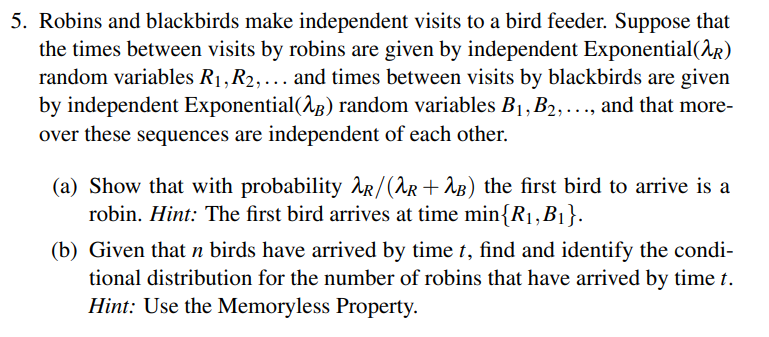5. Robins and blackbirds make independent visits to a bird feeder. Suppose that the times between visits by robins are given by independent Exponential(2) random variables R₁, R₂, ... and times between visits by blackbirds are given by independent Exponential(2) random variables B₁, B₂, ..., and that more- over these sequences are independent of each other. (a) Show that with probability R/(λR +2B) the first bird to arrive is a robin. Hint: The first bird arrives at time min{R₁, B₁}. (b) Given that n birds have arrived by time t, find and identify the condi- tional distribution for the number of robins that have arrived by time t. Hint: Use the Memoryless Property.
5. Robins and blackbirds make independent visits to a bird feeder. Suppose that the times between visits by robins are given by independent Exponential(2) random variables R₁, R₂, ... and times between visits by blackbirds are given by independent Exponential(2) random variables B₁, B₂, ..., and that more- over these sequences are independent of each other. (a) Show that with probability R/(λR +2B) the first bird to arrive is a robin. Hint: The first bird arrives at time min{R₁, B₁}. (b) Given that n birds have arrived by time t, find and identify the condi- tional distribution for the number of robins that have arrived by time t. Hint: Use the Memoryless Property.
Algebra and Trigonometry (MindTap Course List)
4th Edition
ISBN:9781305071742
Author:James Stewart, Lothar Redlin, Saleem Watson
Publisher:James Stewart, Lothar Redlin, Saleem Watson
Chapter14: Counting And Probability
Section14.2: Probability
Problem 3E: The conditional probability of E given that F occurs is P(EF)=___________. So in rolling a die the...
Related questions
Question
5

Transcribed Image Text:5. Robins and blackbirds make independent visits to a bird feeder. Suppose that
the times between visits by robins are given by independent Exponential(2)
random variables R₁, R₂, ... and times between visits by blackbirds are given
by independent Exponential(2) random variables B₁, B₂, ..., and that more-
over these sequences are independent of each other.
(a) Show that with probability R/(λR +2B) the first bird to arrive is a
robin. Hint: The first bird arrives at time min{R₁, B₁}.
(b) Given that n birds have arrived by time t, find and identify the condi-
tional distribution for the number of robins that have arrived by time t.
Hint: Use the Memoryless Property.
Expert Solution
This question has been solved!
Explore an expertly crafted, step-by-step solution for a thorough understanding of key concepts.
This is a popular solution!
Trending now
This is a popular solution!
Step by step
Solved in 2 steps with 2 images

Recommended textbooks for you

Algebra and Trigonometry (MindTap Course List)
Algebra
ISBN:
9781305071742
Author:
James Stewart, Lothar Redlin, Saleem Watson
Publisher:
Cengage Learning

College Algebra
Algebra
ISBN:
9781305115545
Author:
James Stewart, Lothar Redlin, Saleem Watson
Publisher:
Cengage Learning

Algebra & Trigonometry with Analytic Geometry
Algebra
ISBN:
9781133382119
Author:
Swokowski
Publisher:
Cengage

Algebra and Trigonometry (MindTap Course List)
Algebra
ISBN:
9781305071742
Author:
James Stewart, Lothar Redlin, Saleem Watson
Publisher:
Cengage Learning

College Algebra
Algebra
ISBN:
9781305115545
Author:
James Stewart, Lothar Redlin, Saleem Watson
Publisher:
Cengage Learning

Algebra & Trigonometry with Analytic Geometry
Algebra
ISBN:
9781133382119
Author:
Swokowski
Publisher:
Cengage